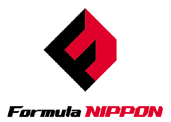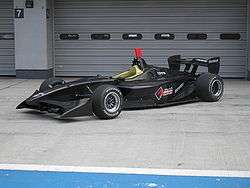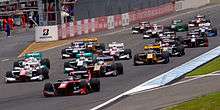Super Formula Championship
 | |
| Category | Single seaters |
|---|---|
| Country |
|
| Inaugural season | 1973 |
| Drivers | 19 |
| Teams | 11 |
| Constructors | Dallara |
| Engine suppliers | Toyota, Honda |
| Tire suppliers | Yokohama |
| Drivers' champion |
|
| Teams' champion | Petronas Team TOM'S |
| Official website | superformula.net |
|
| |
Super Formula, formerly known as Formula Nippon, is a type of formula racing and the top level of single-seater racing in Japan.
Formula Nippon evolved from the Japanese Formula 2000 series begun in 1973 by way of the Japanese Formula Two and Japanese Formula 3000 championships. For the most part, the Japanese racing series have closely followed their European counterparts in terms of technical regulations, but there have been some important exceptions.
History
Formula 2000 (1973–1977)
Background
In Japan, though touring and sports car racing was very popular through the 1960s, formula car racing was less so in those days. Even the Japanese Grand Prix lost its popularity after changing its format from touring/sports car racing to formula car racing in 1971.
In 1973, the Japan Automobile Federation (JAF) established the "All-Japan Formula 2000 Championship" as the first top-level formula racing series in Japan, to promote popularity of formula car racing in the country.
The series was created based on the European Formula Two Championship. But the JAF approved use of purpose built racing engines was different from the European F2 series which only allowed race engines based on mass production models. Due to this difference, the series did not fit in with the Formula Two regulations in those days. Therefore, the series was renamed "Formula 2000", not "Formula Two".
Formula Two (1978–1986)
_front-right_Honda_Collection_Hall.jpg)
The revised Formula Two regulation in 1976 removed the restriction about engines which had limited the use of engines based on mass production models. With this change the reasoning behind the name "Formula 2000" disappeared. It led to the series being renamed the "All-Japan Formula Two Championship" from 1978.
1987 championship
When European Formula Two ended in 1984, its Japanese counterpart did not follow suit immediately. The JAF considered starting a new Formula Two series from 1988. However, all entrants ran Formula 3000 cars in 1987. So, the 1987 Formula Two Championship was cancelled due to no entry of any cars for that format.
Formula 3000 (1987–1995)
Switching to the open Formula 3000 standard in 1987, the "All-Japan Formula 3000 Championship" started in 1988. Once again, Japanese and European regulations paralleled one another until 1996, when the International Formula 3000 series became a one-make format to lower costs.
Thanks to the bubble economy and Formula One-fad in Japan, the series had many entrants and investors. It attracted many promising young drivers outside of Japan to compete in the series. Inevitably, the end of such phenomena led to the decline of the series.
Formula Nippon (1996–2012)

In the mid-1990s, the Japanese Formula broke away, changing the form of the series to "Formula Nippon". The new Japan Race Promotion, formed by Fuji Television, became the promoter with the recognition of the series by the JAF as the Authority Sport Nationale (ASN) of Japan.
In the 2000s, sports car racing became more popular in Japan, and many Formula Nippon drivers doubled-up in the Japanese Super GT championship.
The 2006 season got off to one of the strangest starts in motorsport history. Because of heavy rain, the opener at Fuji was called off after two safety car laps, and Benoît Tréluyer was awarded the win with half points awarded.
Cars

Until recently, Formula Nippon was an open formula, where a variety of chassis builders and engine manufacturers could compete. Chassis were supplied by Lola, Reynard, and G-Force, while Mugen-Honda supplied the vast majority of the engines (though Cosworth engines were found in the Formula 3000 era). However, with the bankruptcy of Reynard in 2002, and the withdrawal of G-Force a year earlier, Formula Nippon once again followed F3000's lead in becoming a one-make series. Formula Nippon cars were now all Lola B03/50 chassis powered by Mugen-Honda engines; however, unlike F3000, engines in Formula Nippon are open-tuned by private companies.
In 2006 Formula Nippon underwent a drastic revision of its regulations. The current Lola B03/50 chassis was replaced by a new Lola FN06 chassis, while the engine formula underwent drastic revision. Engine blocks were provided by Toyota and Honda, using the same engine block specifications as found in the 2005 Indy Racing League, with open-tuning still permitted.
Swift Engineering in San Clemente, California produced the FN09 chassis that was used from 2009 through 2013.
Scoring System
- Points are awarded in line with the standard FIA system used from 2003 to 2009, but with a bonus point given for pole position.
| Position | 1st | 2nd | 3rd | 4th | 5th | 6th | 7th | 8th | Pole |
|---|---|---|---|---|---|---|---|---|---|
| Points | 10 | 8 | 6 | 5 | 4 | 3 | 2 | 1 | 1 |
Super Formula (2013– )
Cars
The base chassis for the series is the Dallara SF14, which was unveiled in Tokyo on 25 March 2013. The car weighs 650 kilograms, and is powered by two-litre single turbo-charged engines from Honda and Toyota, basically the same engines used in Super GT GT500 cars, and very similar to the specification to be used in the Deutsche Tourenwagen Masters (any DTM or Super GT500 manufacturer can participate). It also has a drag reduction system similar to that used in Formula One.
Though the chassis is designed by Dallara, 30% of the car is manufactured in Japan.[1] This current vehicle features the theme of speed-up from previous cars.
Comparable to a contemporary spec-series Indycar, a fast lap time at the Suzuka Circuit in a Super Formula spec-series Dallara, approximately 1:37.000 in qualifying, would be roughly 5 seconds slower than a 2014 specification Formula 1 machine.
Specifications
- Engine displacement: 2.0 L (122 cu in) DOHC inline-4
- Gearbox: 6-speed paddle shift gearbox
- Weight: 1,455 lb (660 kg)
- Power output: 543 hp (405 kW)
- Fuel: 102 RON unleaded gasoline
- Fuel delivery: Direct fuel injection
- Aspiration: Single-turbocharged
- Length: 5,268 mm (207 in)
- Width: 1,910 mm (75 in)
- Wheelbase: 3,165 mm (125 in)
- Steering: Electric power-assisted rack and pinion
Drivers
However, despite the more technically demanding regulations, the Japanese top-level formula series remains a national series, with second tier status compared to the pan-European GP2 Series and its predecessor Formula 3000. Foreign drivers have always been regular participants in the Japanese championships, and there have been several drivers to come from a Japanese Formula 3000 or Formula Nippon drive to a prominent Formula One role; the best-known of these are Eddie Irvine, Ralf Schumacher, the 1996 Formula Nippon champion, and Pedro de la Rosa, the 1997 Formula Nippon champion.
Champions
| Season | Series Name | Drivers' Champion | Team Champion | ||||
|---|---|---|---|---|---|---|---|
| Driver | Team | Chassis* | Engine* | Tyre* | |||
| 1973 | All-Japan Formula 2000 | |
Heros Racing | March 722 | BMW M12/6 | B | Not awarded |
| 1974 | All-Japan Formula 2000 | |
Takahara Racing | March 842 | BMW M12/6 | B | |
| 1975 | All-Japan Formula 2000 | |
Victory Circle Racing | March 742 | BMW M12/6 | B | |
| 1976 | All-Japan Formula 2000 | |
Heros Racing | Nova 512 | BMW M12/7 | B | |
| 1977 | All-Japan Formula 2000 | |
Heros Racing | Nova 512B Nova 532P |
BMW M12/7 | B | |
| 1978 | Japanese Formula Two | |
Heros Racing | Nova 532P Nova 522 |
BMW M12/7 | B | |
| 1979 | Japanese Formula Two | |
Team LeMans | March 782 March 792 |
BMW M12/7 | D | |
| 1980 | Japanese Formula Two | |
Tomica Racing Team | March 802 | BMW M12/7 | B | |
| 1981 | Japanese Formula Two | |
i&i Racing | Ralt RH6/80 March 812 |
Honda RA261E | B | |
| 1982 | Japanese Formula Two | |
Team Ikuzawa | March 812 March 822 |
Honda RA262E | B | |
| 1983 | Japanese Formula Two | |
John Player Special Team Ikuzawa | Spirit 201 March 832 |
Honda RA263E | D | |
| 1984 | Japanese Formula Two | |
Heros Racing | March 842 | Honda RA264E | B | |
| 1985 | Japanese Formula Two | |
Heros Racing with Nakajima | March 85J | Honda RA264E Honda RA265E |
B | |
| 1986 | Japanese Formula Two | |
Heros Racing with Nakajima | March 86J | Honda RA266E | B | |
| 1987 | Japanese Formula 3000 | |
Hoshino Racing | March 87B Lola T87/50 |
Honda RA387E | B | |
| 1988 | Japanese Formula 3000 | |
Footwork Sports Racing Team | March 87B Reynard 88D |
Yamaha OX77 | B | |
| 1989 | Japanese Formula 3000 | |
Auto Beaurex Motor Sport | Lola T88/50 Lola T89/50 |
Mugen MF308 | D | |
| 1990 | Japanese Formula 3000 | |
Cabin Racing Team with Impul | Lola T90/50 | Mugen MF308 | B | |
| 1991 | Japanese Formula 3000 | |
Cabin Racing Team with Heros | Lola T90/50 Lola T91/50 |
Cosworth DFV | B | |
| 1992 | Japanese Formula 3000 | |
Acom Evolution Team Nova | Lola T91/50 Lola T92/50 |
Mugen MF308 | B | |
| 1993 | Japanese Formula 3000 | |
Nisseki Impul Racing Team | Lola T92/50 | Cosworth DFV | B | |
| 1994 | Japanese Formula 3000 | |
Dome | Dome F104 | Mugen MF308 | D | |
| 1995 | Japanese Formula 3000 | |
Hoshino Racing | Lola T94/50 | Mugen MF308 | B | |
| 1996 | Formula Nippon | |
X-Japan Racing Team LeMans | Reynard 96D | Mugen MF308 | B | X-Japan Racing Team LeMans |
| 1997 | Formula Nippon | |
Shionogi Team Nova | Lola T97/51 | Mugen MF308 | (B) | Shionogi Team Nova |
| 1998 | Formula Nippon | |
LEMONed Racing Team LeMans | Reynard 97D | (Mugen MF308) | (B) | LEMONed Racing Team LeMans |
| 1999 | Formula Nippon | |
PIAA Nakajima Racing | Reynard 99L | (Mugen MF308) | (B) | PIAA Nakajima Racing |
| 2000 | Formula Nippon | |
PIAA Nakajima Racing | Reynard 2KL | (Mugen MF308) | (B) | PIAA Nakajima Racing |
| 2001 | Formula Nippon | |
Team Impul | Reynard 99L | (Mugen MF308) | (B) | Team 5Zigen |
| 2002 | Formula Nippon | |
PIAA Nakajima Racing | Reynard 01L | (Mugen MF308) | (B) | PIAA Nakajima Racing |
| 2003 | Formula Nippon | |
Team Impul | (Lola B3/51) | (Mugen MF308) | (B) | Team Impul |
| 2004 | Formula Nippon | |
DoCoMo Team Dandelion Racing | (Lola B3/51) | (Mugen MF308) | (B) | Team Impul |
| 2005 | Formula Nippon | |
Mobilecast Team Impul arting Racing Team with Impul |
(Lola B3/51) | (Mugen MF308) | (B) | Mobilecast Team Impul arting Racing Team with Impul |
| 2006 | Formula Nippon | |
Mobilecast Team Impul | (Lola B06/51 (FN06)) | Toyota RV8J | (B) | Mobilecast Team Impul |
| 2007 | Formula Nippon | |
Mobilecast Team Impul | (Lola B06/51 (FN06)) | Toyota RV8J | (B) | Mobilecast Team Impul |
| 2008 | Formula Nippon | |
Lawson Team Impul | (Lola B06/51 (FN06)) | Toyota RV8J | (B) | Lawson Team Impul |
| 2009 | Formula Nippon | |
Nakajima Racing | (Swift 017.n (FN09)) | Honda HR09E | (B) | Nakajima Racing |
| 2010 | Formula Nippon | |
Mobil 1 Team Impul | (Swift 017.n (FN09)) | Toyota RV8K | (B) | Mobil 1 Team Impul |
| 2011 | Formula Nippon | |
Petronas Team TOM'S | (Swift 017.n (FN09)) | Toyota RV8K | (B) | Petronas Team TOM'S |
| 2012 | Formula Nippon | |
Petronas Team TOM'S | (Swift 017.n (FN09)) | Toyota RV8K | (B) | DoCoMo Team Dandelion Racing |
| 2013 | Super Formula | |
Team Mugen | (Swift 017.n (SF13)) | Honda HR12E | (B) | Petronas Team TOM'S |
| 2014 | Super Formula | |
Petronas Team TOM'S | (Dallara SF14) | Toyota RI4A | (B) | Petronas Team TOM'S |
| 2015 | Super Formula | |
Cerumo Inging | (Dallara SF14) | Toyota RI4A | (B) | Petronas Team TOM'S |
| 2016 | Super Formula | |
P.mu/cerumo・INGING | (Dallara SF14) | Toyota RI4A | (Y) | P.mu/cerumo・INGING |
* The ( ) indicates there were no other supplier or a model in the year.
References
- ↑ Collins, Sam (26 March 2013). "2014 Super Formula concept revealed". racecar-engineering.com. Retrieved 22 September 2016.
